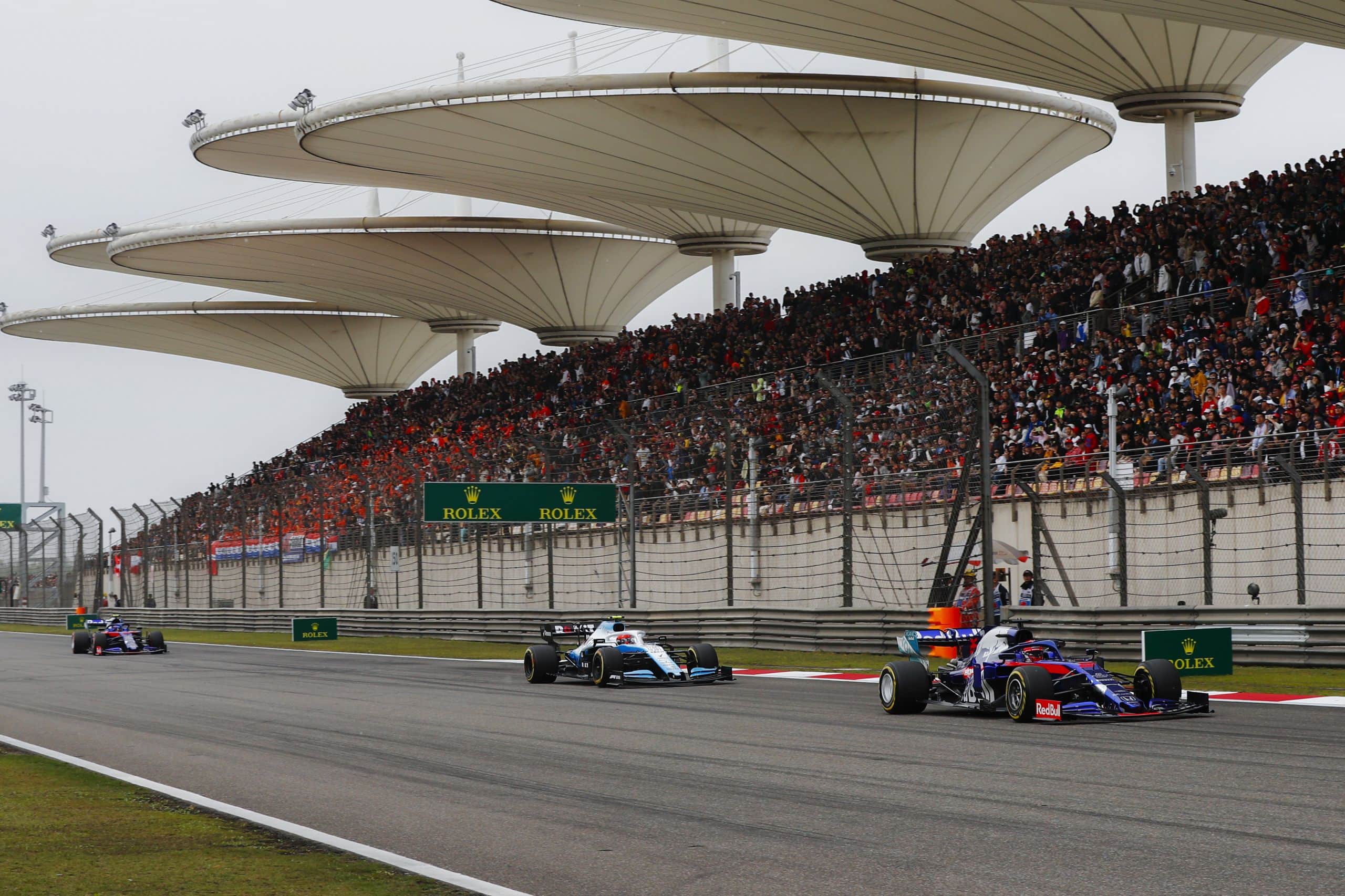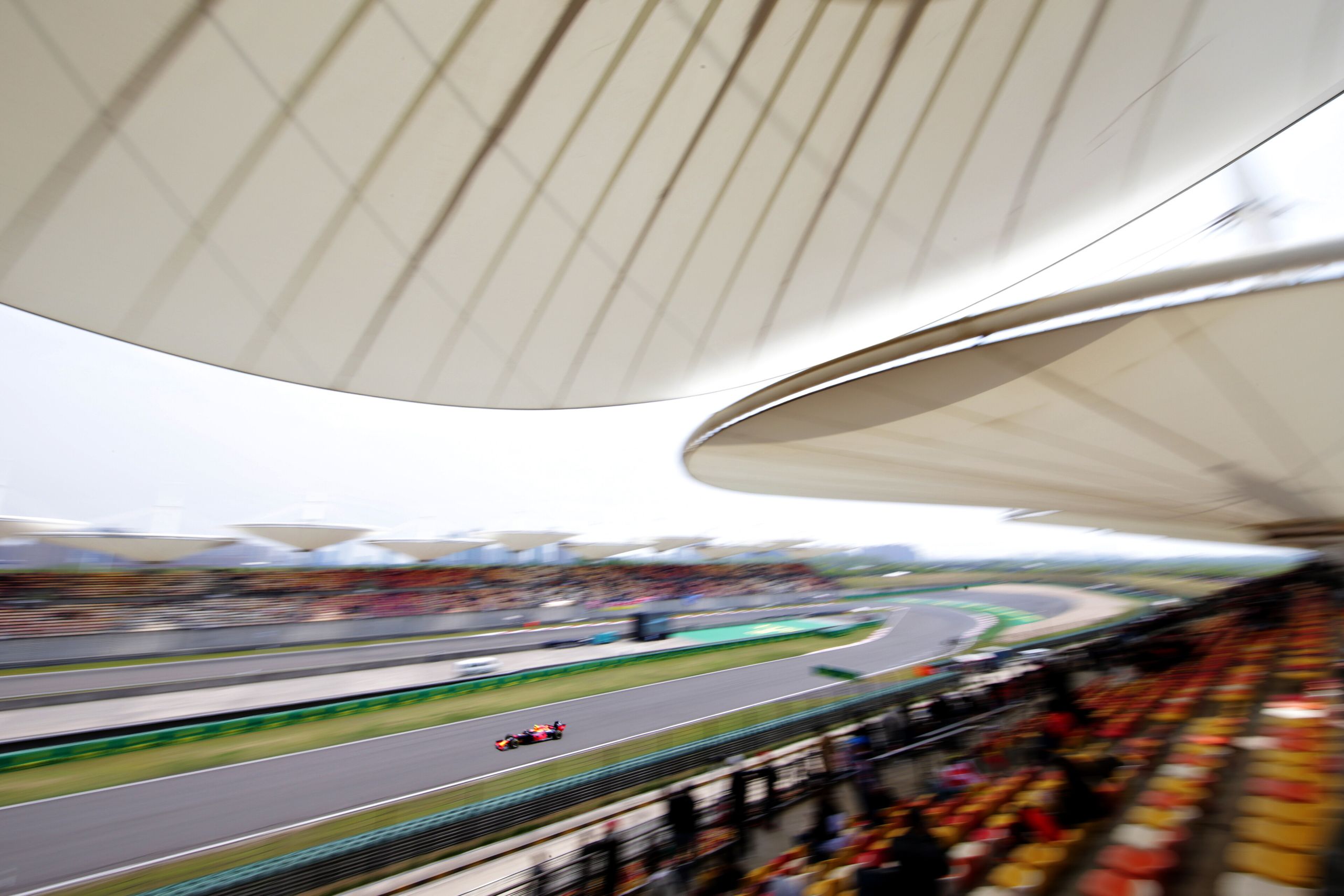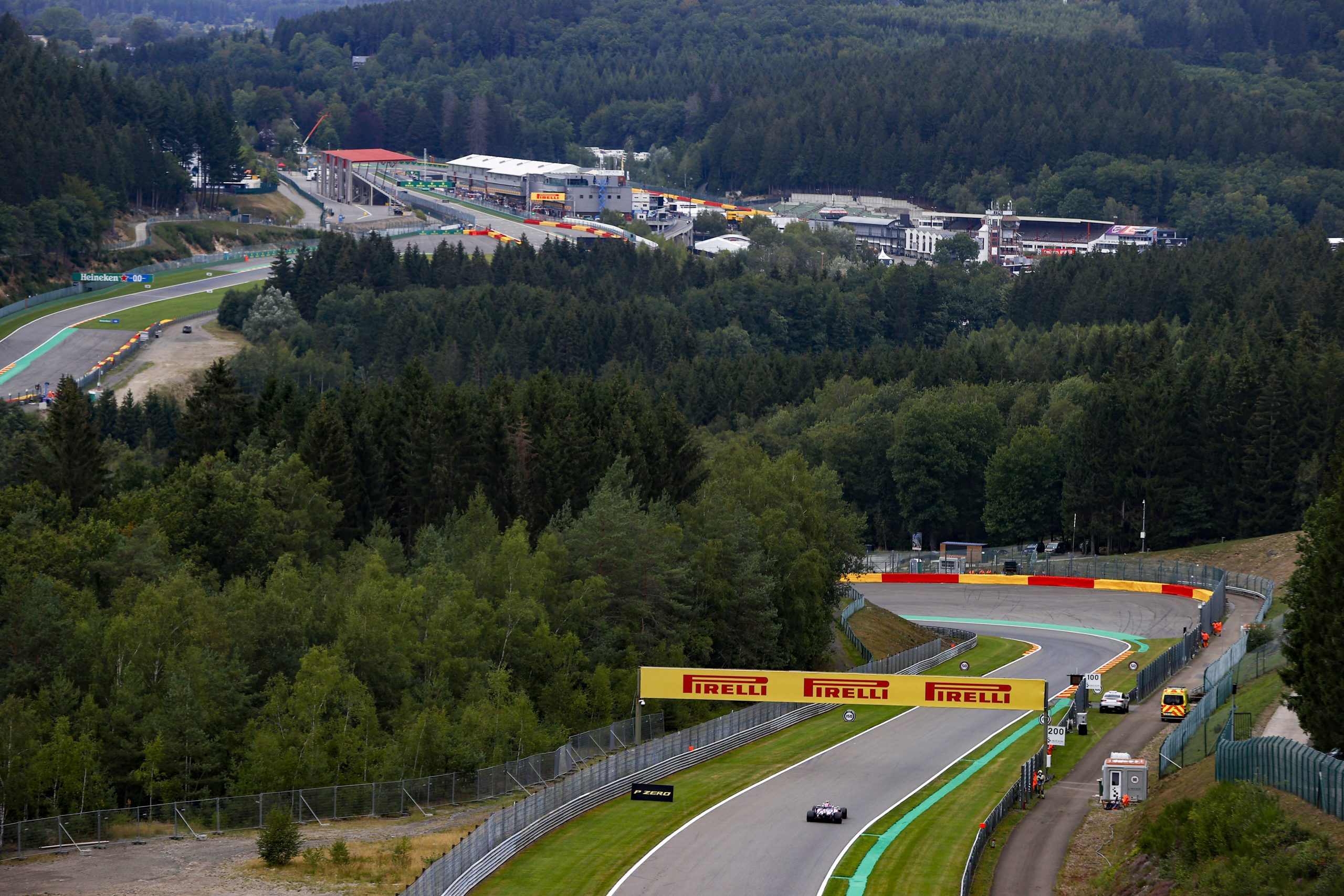Shanghai International Circuit
The Shanghai International Circuit, situated in the Jiading District of Shanghai, is a premier motorsport race track in China. It is prominently recognized for hosting the Chinese Grand Prix, which was first introduced to the Formula 1 calendar in 2004. Constructed on what was once marshland, the circuit has since transformed into a state-of-the-art facility, representing China’s burgeoning influence in international motorsport.
With its inauguration into the world of Formula 1, the Shanghai International Circuit brought forward a blend of traditional Chinese symbols and modern racing technology. This fusion is evident in the track’s layout that mimics the Chinese character ‘shang’, which stands for ‘high’ or ‘above’. As a result, the circuit offers a unique blend of high-speed straights and challenging turns, testing the abilities of the world’s best drivers.
The Shanghai International Circuit features a track length of approximately 5.451 kilometers and challenges drivers over 56 laps during the Grand Prix. It has earned a reputation for its demanding corners, including the tight hairpin at Turn 14 and the high-speed Turn 13 that leads onto the longest straight on the F1 calendar. The track layout pushes the performance of both car and driver, making each race an exciting spectacle for motor racing enthusiasts.
History of Shanghai International Circuit
The Shanghai International Circuit emerged as a landmark project to demonstrate Shanghai’s modernity and capacity to host world-class events. It became China’s premier motorsport venue, committed to hosting the Formula One Chinese Grand Prix since its inauguration.
Construction and Inauguration
The construction of the Shanghai International Circuit began in April 2003 and concluded with grand opening celebrations on June 6, 2004. Designed by renowned architect Hermann Tilke, the circuit represented an engineering marvel, transforming swampland into a state-of-the-art racing facility. The government-funded joint venture, Shanghai Jiushi Group, allocated approximately 2.6 billion yuan ($450 million) to complete the project. Over 3,000 workers were tasked with daily construction duties to meet the ambitious deadline. The resulting complex, complete with paddock facilities modeled after Shanghai’s historic Yu Garden, can accommodate up to 200,000 spectators.
Notable Events and Records
Since its inaugural event in 2004, the Shanghai International Circuit has been the recurring host of the FIA Formula One World Championship’s Chinese Grand Prix. Michael Schumacher’s race lap record of 1:32.238, established during the 2004 Grand Prix, exemplifies the high-performance standards set at the circuit. Other prestigious motorsport events have also graced the track, including the FIA World Endurance Championship and the Blancpain GT Series Asia. Moreover, the circuit’s design, based on the Chinese character ‘shang’, provides a challenging and engaging course for drivers, underlined by the demanding snail-shaped turns and the 1.2 km long back straight, one of the longest in F1 racing.
Renovations and Modernizations
Throughout its history, Shanghai International Circuit has undergone various upgrades to enhance the spectator experience and maintain the highest standards of safety and technology. As it continues to be a central stage for international and domestic racing series, the circuit upholds its FIA Grade 1 status, ensuring that it meets the exacting requirements demanded by the pinnacle of motorsport events.

Design and Layout
The Shanghai International Circuit is an emblem of sophisticated engineering, reflecting Shanghai’s ambition and technological prowess, especially notable in its unique facilities and the culturally inspired track layout.
Track Overview
The circuit stretches over 5.451 kilometers and is known for its remarkable capacity to host up to 200,000 spectators. Designed with inspiration from the Chinese ‘shang’ symbol, it incorporates this cultural element into its overall configuration. A distinctive feature of the Shanghai Circuit is its main grandstand and pit complex, designed to resemble wings that elegantly extend over the track.
Technical Aspects
The track contains a total of 16 corners, including the highly technical turns 1 and 2 where drivers face a challenging radial turn requiring a precise balance of speed and control. Notably, the longest straight on the track measures an impressive 1.2 kilometers, offering drivers an opportunity to reach peak speeds before approaching the tight right-hander of turn 6. This strategic mixture of high-speed straights and tight corners demands a nuanced technical setup and astute driving skills.
Hermann Tilke’s Influence
Renowned track designer Hermann Tilke had a significant role in shaping the circuit’s technical features. His expertise was instrumental in transforming the prior swampy terrain into a modern racing marvel. Tilke’s design accommodates the high-speed demands of Formula One while maintaining the essence of the location’s heritage, an approach that has been praised for its complex integration of high-speed straights and tight, twisty sections, particularly the snake-like turns 7 and 8 which test the limits of car downforce and driver finesse.
Major Races and Events
The Shanghai International Circuit has been an esteemed venue for several high-profile motorsport events, most notably the Formula One Chinese Grand Prix.
Formula One Chinese Grand Prix
The Formula One Chinese Grand Prix is the circuit’s flagship event, having been a staple on the F1 calendar since 2004, except for a hiatus from 2020 to 2023 due to the global situation. This prestigious race is part of the Formula One World Championship, and its return to the circuit is scheduled for 2024. Typically held over 56 laps, the track’s 5.451-kilometer length challenges drivers and teams alike with a mix of high-speed straights and technical corners.
Support Races and Other Events
In addition to the main Grand Prix, the Shanghai International Circuit hosts a range of support races and other motorsport events throughout the year. These include:
- International racing series such as the FIA World Endurance Championship, which often features a six-hour race at the venue.
- The circuit has previously been part of the MotoGP calendar, showcasing the world’s premier motorcycle racing championship.
- Various national and regional races and driving experiences also take place at the circuit, contributing to its reputation as a hub for motorsport in Asia.

Technical Specifications
Showcasing cutting-edge features and a unique layout, the Shanghai International Circuit stands as a testament to modern race engineering with a circuit length challenging to even the most skilled Formula One drivers. It presents an intricate mix of high-speed straights and technical corners that push team strategies and car designs to their limits.
Circuit Length and Lap Data
- Circuit Length: The total length of the Shanghai International Circuit is approximately 5.451 kilometers (3.387 miles).
- Lap Data:
- Number of Laps: F1 races typically run 56 laps.
- Lap Record: The lap record, as of the knowledge cutoff, is held by Michael Schumacher with a time of 1:32.238.
Pit Complex and Team Facilities
- Pit Complex: The Shanghai International Circuit features a modern, state-of-the-art pit complex that includes expansive garage spaces to accommodate F1 teams’ technological and logistical needs.
- Team Facilities: Behind the scenes, teams have access to high-quality facilities within the paddock to plan their race strategy and manage the extensive support required for a successful F1 event.
Infrastructure and Accessibility
The Shanghai International Circuit, with its pioneering grandstand and expansive facilities, has set a high benchmark for modern motorsport venues. Designed with attention to cultural significance and advanced engineering, the circuit accommodates large crowds and offers an immersive spectator experience within close proximity to Shanghai’s many amenities.
Grandstand and Spectator Areas
The main grandstand of the Shanghai International Circuit, which can be seen as a futuristic sculpture that commands views of the winding track, has a seating capacity that contributes to the circuit’s total capability of hosting around 200,000 spectators. Designed by Hermann Tilke and reflective of the paddock area’s homage to the traditional Yuyan-Garden, the grandstand allows for an engaging viewing experience of the races. Fans enjoy the intricate maneuvers of the cars through the circuit’s challenging turns, especially from the vantage point of the grandstand’s higher seats.
Surrounding Facilities
In the vicinity of the Shanghai International Circuit, located in the Jiading District, travelers and fans can find an array of facilities enhancing their visit. Restaurants and hotels are available to accommodate visitors with various budgets, from luxury options to more economical choices, ensuring that all fans can enjoy the event comfortably. Access to the track is facilitated by its connection to Line 11 of the Shanghai Metro, which leads directly to the circuit’s own metro station. The infrastructure is supported by over 40,000 stone pillars to stabilize the ground due to the track being built on marshland. Close to major highways and Shanghai’s two international airports, access to the Shanghai International Circuit is made convenient for both local and international visitors.
Economic and Cultural Impact
The Shanghai International Circuit, located in Jiading, Shanghai, has significantly influenced both the regional development and the realm of motorsport with its role as a prominent venue for Formula 1 (F1) and other global racing events. This impact stretches beyond the track, contributing to Shanghai’s status as a vibrant international hub with substantial economic implications.
Regional Development
The presence of the Shanghai International Circuit has catalyzed development in the surrounding region of Jiading. Infrastructure improvements, as a consequence, are notable, enhancing transport links and utilities to accommodate the influx of visitors. Investments in the local economy are evident through the growth of hospitality and service sectors, driven by the demand from international events held at the circuit.
- Hospitality Growth: Increase in hotels and accommodation facilities.
- Service Sector Expansion: Upsurge in catering, entertainment, and tourism services.
Contribution to Motorsport
As China’s flagship F1 destination, the Shanghai International Circuit is crucial for the promotion and growth of motorsport within the country. The circuit’s design and facilities are reflective of international standards, raising the bar for racing venues in Asia.
- Motorsport Promotion: It serves as a platform for domestic racing talent and enthusiasts.
- Technological Advancements: Incorporates cutting-edge technology and design, influencing other circuits in the region.

Technological Innovations
Shanghai International Circuit is at the forefront of technological integration, boasting significant advancements in engineering and sustainability efforts. The circuit reflects a commitment to cutting-edge technology and innovative engineering solutions, aligning with modern standards set forth by the Fédération Internationale de l’Automobile (FIA).
Engineering and Design Breakthroughs
Engineers have embedded the latest technology into the circuit’s design to enhance the racing experience and safety. Key design features include:
- High-Performance Track Surfaces: Utilizing advanced asphalt technology for optimal grip and durability.
- State-of-the-Art Safety Barriers: Incorporating FIA-approved safety systems for driver protection.
Sustainability and Green Initiatives
The circuit prioritizes green initiatives, aligning with global sustainability efforts. Measures include:
- Renewable Energy Sources: Implementation of solar panels and other renewable energy systems to reduce carbon footprint.
- Water Conservation Systems: Advanced rainwater harvesting and water management strategies to ensure the responsible use of resources.
Fan Experience
The Shanghai International Circuit offers an engaging experience for fans, with the circuit’s grandstands capable of accommodating approximately 200,000 spectators. This capacity ensures that a large number of fans can enjoy the event in person, with tailored services and activities enhancing their visit.
Spectator Services
The Shanghai International Circuit provides ample amenities to ensure that spectators have a comfortable and convenient experience. With numerous grandstands situated around the circuit, fans have a variety of viewing options, from the intensity of the starting grid to the thrilling overtaking zones.
- Seating: Various grandstand options are available, catering to different preferences and budgets.
- Facilities: On-site services include food stalls, restrooms, and first aid stations.
- Accessibility: Services for people with disabilities are available to ensure everyone has a pleasant experience.
Interactive Activities
Beyond the thrilling races, the Shanghai International Circuit engages fans with interactive activities that bring them closer to the action.
- Simulators: Fans can test their driving skills on state-of-the-art racing simulators.
- Merchandise: Official merchandise shops offer fans a chance to own a piece of the Grand Prix.
- Fan Zones: Designated areas where fans can participate in games and potentially meet drivers or other racing personnel.
Visiting the Shanghai International Circuit during the Grand Prix not only promises high-speed action but also an immersive environment where every fan can feel part of the racing spectacle.
Shanghai International Circuit – Frequently Asked Questions
This section provides answers to common inquiries regarding the Shanghai International Circuit, ensuring readers have factual, concise information.
Has F1 ever raced in China?
Yes, Formula 1 has raced in China at the Shanghai International Circuit since 2004, making it a staple on the F1 schedule.
What are the best ways to reach the Shanghai International Circuit?
The Shanghai International Circuit is accessible via the Shanghai Metro’s Line 11. Visitors can also opt for taxis, private transfers, or dedicated shuttle services on race days.
How popular is F1 in China?
Formula 1 has a growing fan base in China, partly due to the annual Chinese Grand Prix held at the Shanghai International Circuit, which has boosted the sport’s popularity in the region.
Who is the only Chinese driver that has ever raced in F1?
Zhou Guanyu is the only Chinese driver who has ever raced in Formula 1. Zhou made his F1 debut in 2022 with Alfa Romeo and retained his seat for the 2024 season with the Stake F1 Team. He is the first and currently only Chinese driver to compete in Formula 1.
Where can I buy Chinese Grand Prix tickets?
Tickets for the Chinese Grand Prix can be purchased through the official Formula 1 website or authorized ticket vendors. It is advisable to buy tickets well in advance due to high demand.

